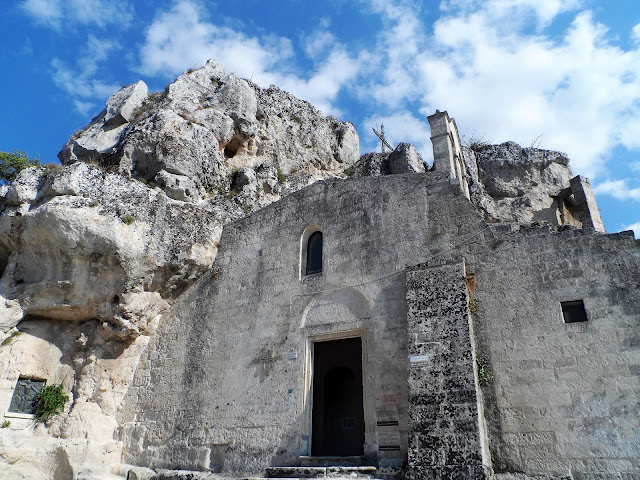Leaving the region of Calabria, we headed into
Basilicata, still following the coastal road (S106), skirting around the
mountainous Pollino.
then slightly inland to the city of Matera.
 |
| Matera |
This unique city sits on the edge of a ravine and
dates from the Middle Ages when Byzantine and Benedictine monks built churches
and monasteries into the rock, known now as the Sassi (stone cave
dwellings). Later farmers and families
moved into the Sassi, making homes, stables and shops out of the rock. The narrow paths meander all around the Sassi,
with some tricky steps to manoeuvre and would be easy to get lost if it not for
the tourist signs hammered into the rock showing you the way!
 |
| Mel finding his way through Sassi’s labyrinth |
It became famous for being used as the setting as
Jerusalem in Mel Gibson’s controversial 2004 film ‘The Passion of Christ’ but known
around here for being the place where people still lived in caves until the
1950’s. Carlo Levi graphically described
the area in his 1945 memoir ‘Christ Stopped at Eboli’ as being impoverished
with malaria-ridden inhabitants. Shortly
after, the Government passed a law to forcibly remove the inhabitants from the
town (20 thousand people) and rehoused them in modern districts in the new town
above. We have been to cave dwellings before but nothing on this scale and it really is a unique sight.
 |
| The single road going around the Sassi |
We had a walk around one of the Case Grotte (Sassi
house), reconstructed using original furniture, utensils and clothes, to try
and get an insight into what life was like for Sassi-dwellers. This one had 3 rooms built on two levels but most
were just one-room dwellings housing large families, along with livestock (only
stuffed ones in here today), living in a one-room dwelling and so it was hard
to imagine the conditions they endured.
 |
| Reconstruction of the room of livestock. Mel couldn't resist stopping a while to chat with the plastic donkey! |
With the input of EU funds, the Sassi district has
been cleaned up and repopulated with homes, B&Bs, hotels, restaurants and
good old souvenir shops. How cute is this! - S & M (Sally and Mel). We found it in one of shops and I was tempted to
buy it, but unfortunately there is nowhere to put it in the motorhome.
In 1993 Matera and its grotto filled outskirts were
declared a UNESCO World Heritage Site and has been declared a European Capital
of Culture for 2019.
The rock church of Santa Maria de Idris, is perched on a rock, rising
from the middle of the Sassi. Inside are
frescoes dating from the 14th century, although a lot are deteriorated due to the humidity and are under constant renovation.
 |
| Santa Maria de Idris |
We could have stayed here all day just admiring the views.
From the top of the city, we could see paths through the ravine that people had walked down from the Sassi and up to the caves, but unfortunately, they have now been blocked off. A short drive around to where the caves are, we got a
birds-eye view over Matera and the Sassi.
And a close up view of where the ‘Sassi meets the
new town above
Looks like Mel has found his ‘man cave’!
Leaving Matera, we came across this Sculpture ‘art’ Park, we drove
passed it at first but then had to go back and have a closer look at this one:
 |
| Car squashed in rock - crazy Italian drivers! |
Mel parked Sonny up in the middle of the park saying he
was the only ‘work of art’ amongst it all!
From Matera, we headed for Taranto and into
Puglia – the heel of the boot.
The roads began to get interesting, as there were
no lines on the road and Italian’s being Italian’s just make up their own laws
for their position in the road and for overtaking!
And driving through the high-rise buildings of Taranto, bus lanes are separated by a metal strip and
nasty spikes sticking up from them.
We are now parked up about 7kms south west of Lecce, at Salento Sosta Camper (N40.28266 E18.13179)
Tomorrow we explore Lecce, dubbed the ‘Florence of the South’
Sally x













No comments:
Post a Comment